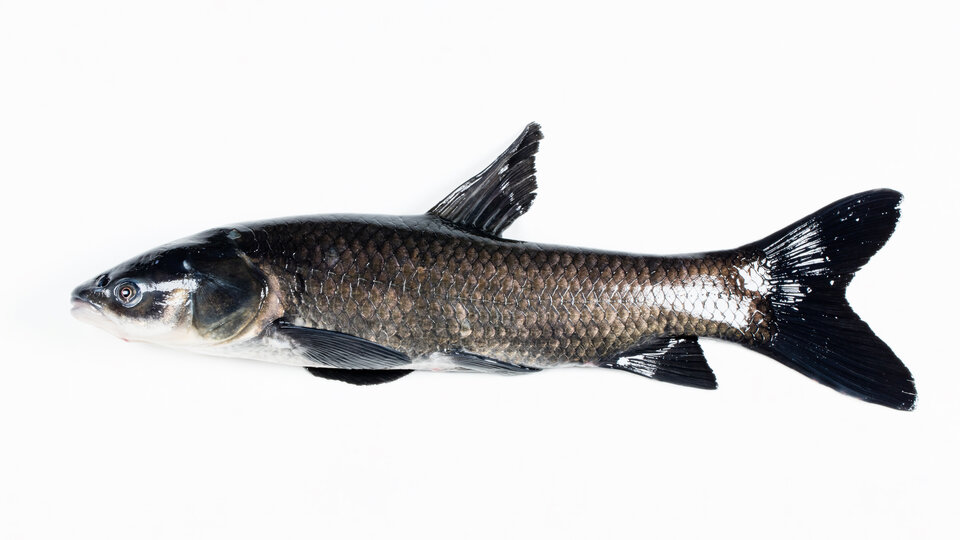General Information
Species Name: Mylopharyngodon piceus
Also Known As: invasive carp, snail carp
Family: Xenocyprididae (Sharpbelly)
Life Span: 15 years
Life Cycle: Adult black carp spawn and fertilize eggs in turbulent waters of rivers where the current drifts eggs downstream for several days. After they hatch, larvae settle into nursery areas that consist of small streams, floodplains and backwater habitats that have little to no current. Larvae and young carp remain in the quiet backwaters until migrating out to deeper pools of large rivers and lakes as adults. Black carp become sexually mature around 4 to 6 years of age, during which they migrate upstream to turbulent waters in late spring and summer to spawn when water temperatures, and or, water levels rise. Both male and females are broadcast spawners. Females release hundreds of thousands of eggs into flowing water.
Origin: Asia
Injurious: Yes. Currently under the Lacey Act, black carp are listed as injurious wildlife by the U.S. Fish and Wildlife Service, which prohibits the importation into or transportation between the continental United States, the District of Columbia, Hawaii, the Commonwealth of Puerto Rico or any territory or possession of the United States of live black carp, gametes, viable eggs and hybrids.
Category 1: Potential Aquatic Invasive Species
Why Are They Invasive?
Black carp have the potential to negatively impact threatened and endangered mollusks, fish, turtles and birds that rely on mollusks as a food source. Based on its dietary habits, the black carp is likely to invade the habitat, feed on and further threaten most of the federally listed freshwater mussels, and about one third of the federally listed aquatic snails, as well as numerous potential candidates for federal protection.
What Do They Look Like?
Black carp are long, narrow-bodied fish. Their body varies from brown to black in color with a bluish-grey to white belly. The fins are brownish-black or black with lighter color at the bases. The scales are large and overlapping with dark edges giving them a cross-hatched appearance. Their heads are scale-less and have a small eye set above the end of their mouth. Mouth is small, terminal and lacks barbels. Black carp have a toothless mouth, but contain a pharyngeal apparatus, also known as throat teeth, that typically form a single row of four to five large molariform teeth on each of the two arches. Their upper jaw is slightly longer than the lower jaw. Adults average around 33 pounds (15 kilometers) but can weigh upwards of 150 pounds (70 kilometers).
Photos

Credit: Columbia Environmental Research Center, Public domain, via Wikimedia Commons

Credit: cjy7, some rights reserved (CC-BY-NC), iNaturalist
Where Do They Live?
Black carp prefer deeper habitats of rivers and lakes. They tend to stick close to the bottom of the water column and rarely come to the surface. They do not leap out of the water like silver carp. Black carp can currently be found in the Mississippi and Ohio River drainages in the following states: Arkansas, Illinois, Kentucky, Louisiana, Mississippi, Missouri, Tennessee, and West Virginia.
How Do They Spread?
Black carp are one of four non-native fish species that belong to a group commonly referred to as invasive carp. Native to eastern Asia, black carp were introduced to the United States during the 1970s to 1980s in imported, contaminated grass carp stocks which were shipped to private fish farms and introduced as a biological control agent in aquaculture farms to stop the spread of disease-carrying pests like yellow grub (Clinostomum margaritum) and snails in aquaculture ponds. They were also imported as a potential food source. By the 1990s, black carp had escaped into the Mississippi River drainage due to high water flooding events.
How Do I Control Them?
Management of invasive fish involving either mechanical removal or application of chemicals to public waters requires a permit. Contact the Contact the Nebraska Game and Parks Commission for more information.
CLEAN your watercraft, trailer, angling gear and other equipment. Remove all aquatic vegetation and animal species from your equipment.
DRAIN your watercraft at the ramp by removing the boat plug and draining all live wells and ballast tanks.
DRY your watercraft, trailer and other equipment for at least 7 days before visiting another waterbody.
DON'T DUMP BAIT. Dispose of bait by emptying bait buckets on dry land, away from waterbodies or in a trash receptacle. Moving a live organism from one waterbody to another is illegal, even if you are planning to use the organism as bait.
DON'T LET IT LOOSE. Do not release or transport exotic or non-native fish species to new ecosystems. It is unlawful to release any aquatic species into a waterbody other than the one from which it was harvested. Doing so can promote the spread of AIS.
What Should I Do If I See Them in Nebraska?
If you see black carp in Nebraska, you should report them to the Nebraska Game and Parks Commission's Aquatic Invasive Species (AIS) Program using their AIS Report Form. For guidance on what information to include in your report, check out our reporting tips.
References and More Information
Center for Invasive Species and Ecosystem Health
Fowler, E. (2021). Carp Roundup. Nebraskaland Magazine/Nebraska Game and Parks Commission.
Nebraska Game and Parks Commission


